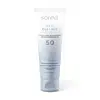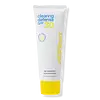What's inside
What's inside
 Key Ingredients
Key Ingredients

 Benefits
Benefits

 Concerns
Concerns

 Ingredients Side-by-side
Ingredients Side-by-side

Homosalate 10%
Skin ConditioningOctocrylene 10%
UV AbsorberEthylhexyl Salicylate 5%
UV AbsorberButyl Methoxydibenzoylmethane 3%
UV AbsorberCaprylic/Capric Triglyceride
MaskingHomosalate 10%, Octocrylene 10%, Ethylhexyl Salicylate 5%, Butyl Methoxydibenzoylmethane 3%, Caprylic/Capric Triglyceride, Stearalkonium Hectorite, Polymethylsilsesquioxane, Euphorbia Cerifera Wax, Copernicia Cerifera Wax, Bentonite, Propylene Carbonate, Dimethicone, Tetrahexyldecyl Ascorbate, Tocopheryl Acetate, Ferulic Acid
Water
Skin ConditioningHomosalate
Skin ConditioningOctocrylene
UV AbsorberButylene Glycol
HumectantEthylhexyl Salicylate
UV AbsorberSilica
AbrasiveButyl Methoxydibenzoylmethane
UV AbsorberC12-15 Alkyl Benzoate
AntimicrobialButyloctyl Salicylate
Skin ConditioningVp/Eicosene Copolymer
Polyglyceryl-2 Distearate
EmulsifyingSaccharide Isomerate
HumectantTapioca Starch
Coriandrum Sativum Fruit Oil
MaskingCamellia Sinensis Leaf Extract
AntimicrobialSodium Ascorbyl Phosphate
AntioxidantSalix Alba Bark Extract
AstringentTerpineol
MaskingThymol
AntimicrobialCitrus Aurantium Dulcis Peel Oil
MaskingDipotassium Glycyrrhizate
HumectantTocopheryl Acetate
AntioxidantPotassium Cetyl Phosphate
EmulsifyingArachidyl Alcohol
EmollientGlyceryl Stearate
EmollientPEG-100 Stearate
Behenyl Alcohol
EmollientXanthan Gum
EmulsifyingAcrylates/C10-30 Alkyl Acrylate Crosspolymer
Emulsion StabilisingArachidyl Glucoside
EmulsifyingEthylhexylglycerin
Skin ConditioningTrisodium Ethylenediamine Disuccinate
Citric Acid
BufferingSodium Citrate
BufferingSodium Hydroxide
BufferingGlycerin
HumectantBisabolol
MaskingPentylene Glycol
Skin ConditioningPropanediol
SolventHydroxyacetophenone
AntioxidantCaprylyl Glycol
EmollientPotassium Sorbate
PreservativeSodium Benzoate
MaskingLinalool
PerfumingLimonene
PerfumingGeraniol
PerfumingCitronellol
PerfumingWater, Homosalate, Octocrylene, Butylene Glycol, Ethylhexyl Salicylate, Silica, Butyl Methoxydibenzoylmethane, C12-15 Alkyl Benzoate, Butyloctyl Salicylate, Vp/Eicosene Copolymer, Polyglyceryl-2 Distearate, Saccharide Isomerate, Tapioca Starch, Coriandrum Sativum Fruit Oil, Camellia Sinensis Leaf Extract, Sodium Ascorbyl Phosphate, Salix Alba Bark Extract, Terpineol, Thymol, Citrus Aurantium Dulcis Peel Oil, Dipotassium Glycyrrhizate, Tocopheryl Acetate, Potassium Cetyl Phosphate, Arachidyl Alcohol, Glyceryl Stearate, PEG-100 Stearate, Behenyl Alcohol, Xanthan Gum, Acrylates/C10-30 Alkyl Acrylate Crosspolymer, Arachidyl Glucoside, Ethylhexylglycerin, Trisodium Ethylenediamine Disuccinate, Citric Acid, Sodium Citrate, Sodium Hydroxide, Glycerin, Bisabolol, Pentylene Glycol, Propanediol, Hydroxyacetophenone, Caprylyl Glycol, Potassium Sorbate, Sodium Benzoate, Linalool, Limonene, Geraniol, Citronellol
Ingredients Explained
These ingredients are found in both products.
Ingredients higher up in an ingredient list are typically present in a larger amount.
Also known as Avobenzone, this ingredient is a chemical sunscreen filter that provides protection in the UV-A range.
Avobenzone is globally approved and is the most commonly used UV-A filter in the world.
Studies have found that avobenzone becomes ineffective when exposed to UV light (it is not photostable; meaning that it breaks down in sunlight). Because of this, formulations that include avobenzone will usually contain stabilizers such as octocrylene.
However, some modern formulations (looking at you, EU!) are able to stabilize avobenzone by coating the molecules.
Avobenzone does not protect against the UV-B range, so it's important to check that the sunscreen you're using contains other UV filters that do!
The highest concentration of avobenzone permitted is 3% in the US, and 5% in the EU.
Learn more about Butyl MethoxydibenzoylmethaneEthylhexyl Salicylate is an organic compound used to block UV rays. It primarily absorbs UVB rays but offers a small amount of UVA protection as well.
Commonly found in sunscreens, Ethylhexyl Salicylate is created from salicylic acid and 2-ethylhexanol. You might know salicylic acid as the effective acne fighter ingredient and BHA.
The ethylhexanol in this ingredient is a fatty alcohol and helps hydrate your skin, similar to oils. It is an emollient, which means it traps moisture into the skin.
According to manufacturers, Ethylhexyl Salicylate absorbs UV wavelength of 295-315 nm, with a peak absorption at 307-310 nm. UVA rays are linked to long term skin damage, such as hyperpigmentation. UVB rays emit more energy and are capable of damaging our DNA. UVB rays cause sunburn.
Learn more about Ethylhexyl SalicylateHomosalate is a chemical sunscreen filter that provides protection in the UV-B range (280nm - 320 nm), with a peak protection at 306 nm. It is internationally approved for use in sunscreens.
Homosalate is not photo-stable, meaning it's strength as a UV filter degrades over time with exposure to the sun. Because of this, it's often used in combination with other chemical sunscreen filters as avobenzone (which protects from the UV-A range). Homosalate also helps act as a solvent for harder-to-dissolve UV filters.
(Part of the reason that sunscreens need to be frequently re-applied is due to the photo instability of many chemical sunscreen filters)
Currently, homosalate is approved in concentrations up to 10% in the EU and 15% in the US. The FDA is currently doing further research on the effects of homosalate, and it is possible that these approved concentrations will change in the future.
Learn more about HomosalateOctocrylene protects skin from sun damage. It absorbs UV-B with peak absorption of 304 nm. It is a common sunscreen ingredient and often paired with avobenzone, a UVA filter. This is because octocrylene stabilizes other sunscreen ingredients by protecting them from degradation when exposed to sunlight. Octocrylene is a photostable ingredient and loses about 10% of SPF in 95 minutes.
Octocrylene also acts as an emollient, meaning it helps skin retain moisture and softens skin. It is oil-soluble and hydrophobic, enhancing water-resistant properties in a product.
Those who are using ketoprofen, a topical anti-inflammatory drug, may experience an allergic reaction when using octocrylene. It is best to speak with a healthcare professional about using sunscreens with octocrylene.
The EU allows a maximum of these concentrations:
Learn more about OctocryleneTocopheryl Acetate is AKA Vitamin E. It is an antioxidant and protects your skin from free radicals. Free radicals damage the skin by breaking down collagen.
One study found using Tocopheryl Acetate with Vitamin C decreased the number of sunburned cells.
Tocopheryl Acetate is commonly found in both skincare and dietary supplements.
Learn more about Tocopheryl Acetate